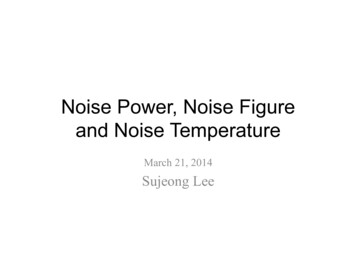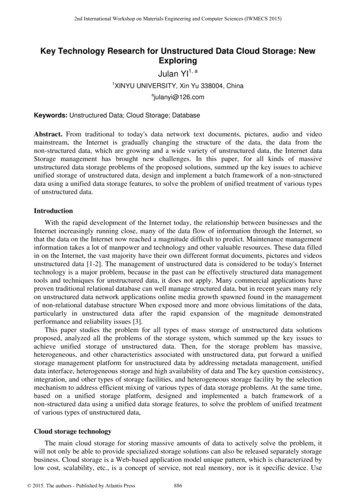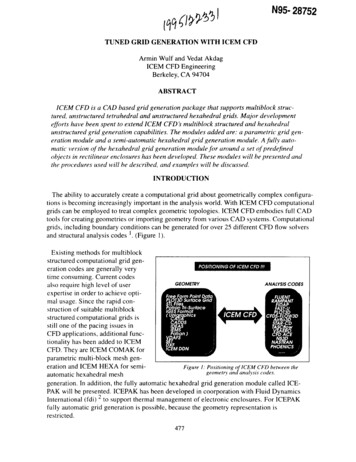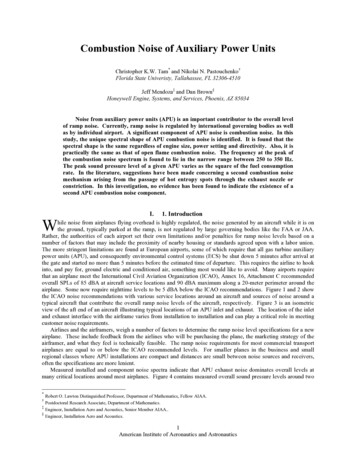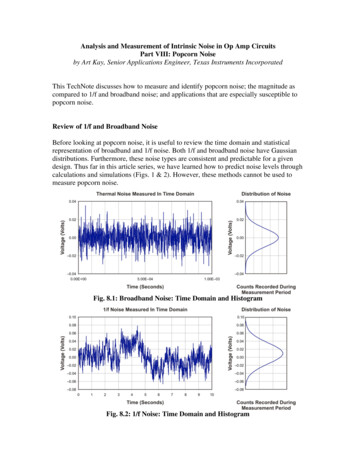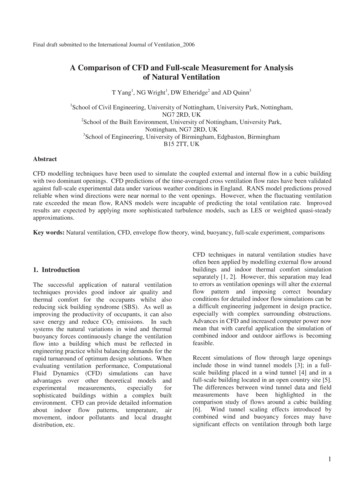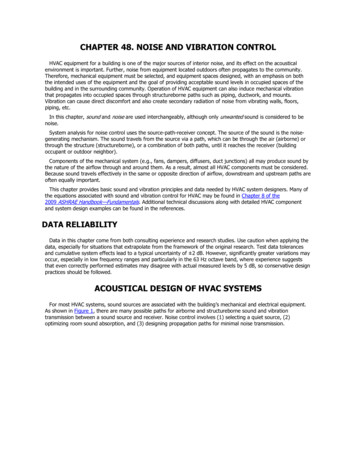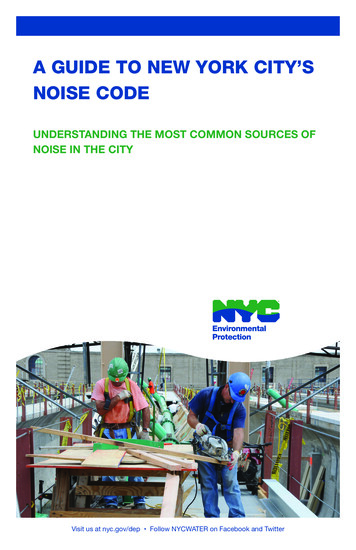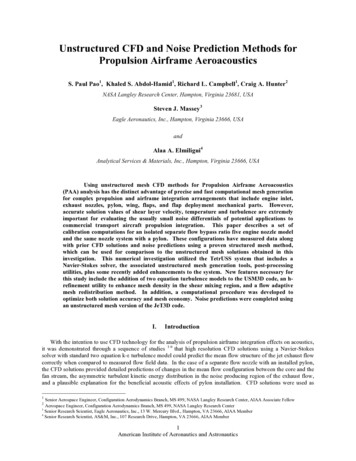
Transcription
Unstructured CFD and Noise Prediction Methods forPropulsion Airframe AeroacousticsS. Paul Pao1, Khaled S. Abdol-Hamid1, Richard L. Campbell1, Craig A. Hunter2NASA Langley Research Center, Hampton, Virginia 23681, USASteven J. Massey 3Eagle Aeronautics, Inc., Hampton, Virginia 23666, USAandAlaa A. Elmiligui4Analytical Services & Materials, Inc., Hampton, Virginia 23666, USAUsing unstructured mesh CFD methods for Propulsion Airframe Aeroacoustics(PAA) analysis has the distinct advantage of precise and fast computational mesh generationfor complex propulsion and airframe integration arrangements that include engine inlet,exhaust nozzles, pylon, wing, flaps, and flap deployment mechanical parts. However,accurate solution values of shear layer velocity, temperature and turbulence are extremelyimportant for evaluating the usually small noise differentials of potential applications tocommercial transport aircraft propulsion integration. This paper describes a set ofcalibration computations for an isolated separate flow bypass ratio five engine nozzle modeland the same nozzle system with a pylon. These configurations have measured data alongwith prior CFD solutions and noise predictions using a proven structured mesh method,which can be used for comparison to the unstructured mesh solutions obtained in thisinvestigation. This numerical investigation utilized the TetrUSS system that includes aNavier-Stokes solver, the associated unstructured mesh generation tools, post-processingutilities, plus some recently added enhancements to the system. New features necessary forthis study include the addition of two equation turbulence models to the USM3D code, an hrefinement utility to enhance mesh density in the shear mixing region, and a flow adaptivemesh redistribution method. In addition, a computational procedure was developed tooptimize both solution accuracy and mesh economy. Noise predictions were completed usingan unstructured mesh version of the JeT3D code.I.IntroductionWith the intention to use CFD technology for the analysis of propulsion airframe integration effects on acoustics,it was demonstrated through a sequence of studies 1-6 that high resolution CFD solutions using a Navier-Stokessolver with standard two equation k-! turbulence model could predict the mean flow structure of the jet exhaust flowcorrectly when compared to measured flow field data. In the case of a separate flow nozzle with an installed pylon,the CFD solutions provided detailed predictions of changes in the mean flow configuration between the core and thefan stream, the asymmetric turbulent kinetic energy distribution in the noise producing region of the exhaust flow,and a plausible explanation for the beneficial acoustic effects of pylon installation. CFD solutions were used as1Senior Aerospace Engineer, Configuration Aerodynamics Branch, MS 499, NASA Langley Research Center, AIAA Associate FellowAerospace Engineer, Configuration Aerodynamics Branch, MS 499, NASA Langley Research Center3Senior Research Scientist, Eagle Aeronautics, Inc., 13 W. Mercury Blvd., Hampton, VA 23666, AIAA Member4Senior Research Scientist, AS&M, Inc., 107 Research Drive, Hampton, VA 23666, AIAA Member21American Institute of Aeronautics and Astronautics
input data for the Jet3D code to predict noise and noise differentials between different configurations. Thisapproach was also used to correlate noise with the aerodynamics induced by a variety of nozzle configurations andpylon installation effects. All these previous studies were conducted using the PAB3D1 code, a general purposestructured Navier-Stokes solver that contains many advanced turbulence models and boundary conditions suitablefor propulsion airframe integration investigations. The computational mesh for these studies were generally in therange of 8 to 16 million cells. The time and effort for grid generation were nominally acceptable for configurationswith moderate degrees of complexity. On the other hand, the topology for a separate flow nozzle system with anisolated pylon is relatively simple when compared with a typical commercial aircraft engine installation that wouldinclude also the wing, high lift flap and aileron systems, and other structural components that may interact with theengine exhaust flow. Alternately, laboratory installations for propulsion airframe aeroacoustics measurementswould have support systems for subassemblies of engine and airframe components. A realistic CFD simulationwould include many of these components in the computational domain. The time and cost to generate structuredgrids for these realistic configurations would be prohibitive in a typical research environment.A logical alternative would be to use unstructured mesh computational methods. Currently available technologyhas shown that grid generation for complex aerodynamic configurations can be fast, efficient and accurate. On theother hand, shear flow mixing computation requires a two-equation turbulence model, and the unstructured NavierStokes codes available to the authors at the beginning of this study did not have a two-equation turbulence modelimplementation. In addition, there was no convenient procedure for unstructured grid generation to concentrate celldensity in features such as a shear layers, wakes, or vortices in the volume of the computational domain. Even whenthese immediate difficulties were somehow resolved, it would be necessary to establish criteria for grid quality andprocedures for computation such that accurate computations are converged, repeatable, and validated. Theremainder of this paper will provide an outline for turbulence model implementation, unstructured mesh refinementmethods, mesh enhancement by flow adaptation, grid convergence for aerodynamics and noise prediction. Twoseparate flow nozzle configurations are used in this study because these configurations are generic in nature, andboth measured data and prior structured grid CFD solutions are available for comparison and validation purposes.Flow simulation results and noise predictions for these two selected configurations will be discussed in detail.II.Computational Method and Grid GenerationThe NASA Tetrahedral Unstructured Software System (TetrUSS)7 is a complete flow analysis system that hasbeen widely used in industry and government since 1991. Its strength is derived from harnessing various componenttechnologies into a user-friendly system to provide rapid, higher-order analysis and design capability to the appliedaerodynamicist. TetrUSS consists of loosely integrated, user-friendly software that comprises a geometry setup toolGridTool8, a tetrahedral grid generator VGRID9,10, a flow solver USM3D11,12, and post-processing grid repair,visualization, and data extraction utilities. The extensions addressed in this paper pertain to the USM3D flow solverand will be described below. In addition to the standard features of the TetrUSS system, this section will alsodescribe several other computational methods and a noise prediction method used in this study.A. USM3D Flow SolverUSM3D is a tetrahedral cell-centered, finite volume Euler and Navier-Stokes (N-S) flow solver. Inviscid fluxquantities are computed across each cell face using Roe’s13 flux-difference splitting (FDS). Spatial discretization isaccomplished by a novel reconstruction process14 based on an analytical formulation for computing solutiongradients within tetrahedral cells. The solution is advanced to a steady state condition by an implicit backward-Eulertime-stepping scheme15. Turbulence models in USM3D include the one equation Spalart-Allmaras (SA) model16,which can be coupled with a wall function to reduce the number of cells in the sublayer region of the boundarylayer, the two-equation k-! turbulence model17 and the Menter SST two-equation model18. These turbulence modelshave undergone rigorous testing on propulsion afterbody flows by Hamid et al.19 The nonlinear algebraic Reynoldsstress models (ARSM) by Girimaji20 and Shih et al. 21 have also been installed in USM3D and are undergoingverification testing. The two-equation turbulence models were added to USM3D in the past few years mainly tomeet the simulation requirements for propulsion airframe integration and high angle of attack flow conditions whereshear layers, flow separation, and vortices are often the dominant components within the flow domain. AdditionalUSM3D code features can be found in Frink et al. and Pandya et al. 23-252American Institute of Aeronautics and Astronautics
B. Grid Generation and Refinement ToolsGrid generation in this study follows the standard procedure in the TetrUSS system. The geometry is firstprepared in GridTool, followed by the generation of surface mesh, viscous layer near solid surfaces, and tetrahedralcell generation in the Euler domain using VGRID. The next step is to enhance the cell density within a volumewhere the jet exhaust turbulent mixing layer will be located. This is accomplished by repeated h-refinement (spatialrefinement) using a software package that is especially design and written for this study by Pao and by Hamid. Thesame h-refinement tool is used again to further enhance the grid quality in later stages of the flow solutiondevelopment process.C. Adaptive Grid EnhancementTwo flow adaptive methods are used in this study. The first one is a grid movement algorithm to adapt the meshto flow gradients in the solution. In a r-refinement method developed by Campbell, a highly sensitive formulationbased on the spring analogy adjusts the distance between neighboring nodes to equalize the gradient representationbetween nodes. Within each cycle of mesh adaptation to an intermediate flow solution, the grid node positionadjustment is an iterative process. The number of iterations to attain better results is determined by the user. For theflow simulation requirements in this study, this mesh adaptive process would repeat somewhere between eight totwenty cycles, depending on the original mesh density. In this adaptive method, the number of mesh nodes andconnectivity are not changed. Again, the number of solution iterations to reduce the flow solution residual betweenflow adaptation steps is optionally determined by the user according to the flow situation and mesh density. Thisadaptive process ends when flow features in the intermediate solutions settle into a steady state.The second flow adaptive method is to refine the mesh in regions where the solution residual is the highest. Theresidual for the five primitive flow variables at each cell is written to a file at the end of computations. Cellstargeted for refinement are selected if a weighted and normalized value of the residual falls within a user determinedrange. The mesh is then selectively refined using the h-refinement tool according to a list of the identified cells, andcomputation is continued on the refined mesh.D. Solution InterpolationExperience from structured mesh shear flow computations indicated that grid sequencing would help the properdevelopment of turbulence levels from the uniform initial conditions in the computational domain containingboundary layers and shear layers. While grid sequencing is natural and easily managed in a structured mesh, it isnot the same in unstructured mesh computations because there is no explicit sequence in the unstructured meshitself. For a computational process that continues from one mesh to another in the course of a single flowsimulation, a solution interpolation utility is very useful. A flow solution interpolation method based on the octreealgorithm was design and coded by Massey and it is used extensively in this study to copy the flow solution from acoarser mesh to a finer mesh, or sometimes just to another mesh of better quality.E. The Jet3D Noise Prediction CodeThe Jet3D software4,26,27 was used for noise prediction and jet noise source diagnostics in this study. Jet3D isbased on a modern implementation of Lighthill’s Acoustic Analogy (LAA) with anisotropic Reynolds stressmodeling, and has been developed to handle complex three-dimensional turbulent flows and installed jetconfigurations. As discussed by Hunter and Thomas2, previous Jet3D SPL predictions were in good agreement withexperimental noise measurements in the inlet arc, for configurations used in this study. Jet arc predictions weregood up to about 121 inlet angle, beyond which Jet3D under predicted low frequency SPL levels (due to inherentlimitations in the implementation of LAA used in Jet3D). Jet3D predicted full-scale-equivalent EPNL within thestandard deviation band of measured data. For the current study, Jet3D was modified to handle unstructured CFDdata from USM3D. Minimal changes were required to compute noise on tetrahedral cells, because of the finitevolume formulation of Jet3D (originally developed for hexahedral cells in structured CFD grids).3American Institute of Aeronautics and Astronautics
III.Computational Procedures of Separate Flow Nozzles with and without a PylonTwo configurations were selected for this evaluation/validation study of using an unstructured mesh for flowsimulation and noise prediction. The first configuration, CF1, was a fan and core separate flow round nozzle with abypass ratio (BPR) of 5. Although the exhaust flow was expected to be axisymmetric, the mesh was made for halfof the nozzle bounded by a vertical plane of symmetry. The second configuration, CF6, was the same nozzle systemwith a pylon having a shape and position similar to a large commercial aircraft installation. The flow conditions forthe fan stream, the core stream, and the ambient atmosphere are nominally those for airplane takeoff simulations.Measurements and structured mesh flow simulations using these identical configurations and flow conditions werepreviously reported in Massey et al.5 and Thomas et al.6. The flow conditions are given in Table I.Table I: Ambient and engine exhaust flow conditionsAcoustic Wind TunnelFan StreamCore StreamTotal Pressure, psi14.7024.3621.72Total Temperature, R5306471491Mach Number0.2800.9310.823Several grids were made for each of these two configurations. A grid convergence study was performed usingCF1. Four levels of mesh were made for this purpose: coarse, medium, fine, and superfine. Two levels of meshwere made for CF6: fine and superfine. In addition to this group of grids, two initial grids, one for eachconfiguration, containing only high quality mesh for the nozzle interior and near the pylon surfaces were generatedfor the purpose of rapid development of boundary layer flows next to the solid surfaces.The coarse, medium, and fine meshes were generated such that the grid quality and relative cell size distributionthroughout the flow domain were similar. This was accomplished by utilizing the “ifact” parameter in VGRID as acontrol for the Euler cell size in each mesh. The relative ratio of cell sizes in the coarse, medium, and fine grids areapproximately 1.4, 1.0, and 0.7, respectively. These grids then went through an identical four-step h-refinementprocess to create a working mesh for computations. The total cell count ratio between mesh levels wasapproximately a factor of 2. The superfine mesh was constructed from the fine mesh by h-refinement of selectedcells in the shear layer where the residual values are the highest. The total cell count for this refinement increasedagain by a factor of two. This selective refinement process created a similarity between these finest grid levels thatis somewhat different from the similarity between the lower three mesh levels. It is worth noting that in all thesemeshes, cell density in the jet mixing domain maintained a very slow linear cell size expansion along the jet plumestreamwise direction. This nearly constant cell size in a local region is necessary for better turbulent flowdevelopment, an experience learned from many years of structured mesh jet exhaust flow simulations. The rule ofthumb is that a minimum of 20 cells per jet diameter in the stream-wise direction should be maintained in a fine gridfor the development of a good quality flow solution. Mesh size details are given in Table II.The CF1 and CF6 flow simulations used the RANS solver in USM3D and the standard k-! turbulence model(according to the Jones-Launder formulation) with a linear Reynolds stress model. A converged viscous solutionwas produced for each configuration using an initial mesh that provided fine details in only the nozzle and pylonneighborhood with minimal enhancements in the jet exhaust flow domain. It took approximately 10,000 to 12,000iterations to establish the velocity and temperature distributions in the nozzle boundary layer and the internal flowpaths. For the CF1 case, this solution was interpolated to the coarse, medium, and fine mesh as their respectivestarting solution. For the CF6 case, the initial nozzle solution was interpolated to the fine mesh as its startingsolution. For each of these meshes, it took approximately 4000 iterations for convergence to a solution where theresidual would level off to a constant value.4American Institute of Aeronautics and Astronautics
Table II: Grid sizes at various density levels for CF1 and CF6Grid NameCF1 CoarseCF1 MediumCF1 FineCF1 Super FineCF6 FineCF6 Super 966,949,309Total 47440,821,251Viscous 428,750Inviscid 78737,392,501At this stage, regardless of the mesh density level, the length of the total temperature core length fell far shortof the expected core length value according to either experimental measurements or previous structured meshcomputations using PAB3D. Two primary factors led to this rapid mixing in numerical simulation. First, the heightof the tetrahedral cells were too large relative to the shear layer such that different layers of the shear flow wouldenter a single cell, and each flow variable was then averaged to a single cell center value. Second, the typical Eulercell in the mesh is isotropic and therefore not efficient in supporting the shear flow gradient that has by nature adirectional preference. During preliminary stages of this study, it was discovered that cell densities up to four timesof the current fine mesh did not entirely solve the problem of insufficient shear flow representation. Instead ofattacking the problem by seeking even high mesh density, mesh enhancement by adapting to flow was pursuedinstead. The Campbell adaptive mesh node positioning method had the distinct advantage of multiple adaptivecycles within one run without user intervention. In this study, a 250 solution-iteration step was conservativelychosen for reducing the solution residual between mesh adaptation cycles. Somewhere between 8 and 20 meshadaptive cycles were used for various solutions to establish an appropriate cell distribution in the shear layers in thecomputational domain. On account of the flow topology and the nature of the spring-analogy mesh movementalgorithm, the shear layer’s demand for high density resulted in cell depletion near the jet flow axis. The situationwas remedied quite easily by a single step of h-refinement in the depleted region after the adaptive cycles werecompleted. A converged solution was then obtained from this adapted and repaired mesh. In order to convincinglyestablish grid convergence of the aerodynamic solutions and to provide a measure of grid sensitivity for noiseprediction using Jet3D, a super-fine mesh was produced for CF1 and CF6. A different strategy was used to furtherenhance the grid. An algorithm designed by Hamid selected cells with the highest values of residual error andrefinined these cells through h-refinement. The refined mesh would therefore support a better flow resolution andquality of the predicted shear layer.IV.Discussion of USM3D Flow Simulation ResultsSince this is a first study of separate flow engine exhaust simulation using unstructured mesh and the USM3Dcode, the simpler CF1 configuration served as the basis for demonstrating solution convergence behavior and gridconvergence of the solution. As mentioned in the previous section, the solution development process took severalsteps from start to finish. Figure 1 shows the convergence history for the CF1 fine mesh case. Using a generic meshthat contained a fine mesh in the vicinity of the nozzle assembly, an initial solution was developed in 10000iterations. At that point, h-refinement was use to bring the mesh to fine grid level by enhancing the mesh densitythroughout the exhaust mixing flow domain such that a minimum of 30 cells per diameter was achieved from thenozzle exit to X/D 30. The initial generic solution was interpolated to the new mesh and developed to more thanfour orders of magnitude of residual reduction. The flow adaptive process started at this point and concluded after14 cycles of flow adaptation. The solution was again developed for several thousand iterations. It was noted thatsolution residual reduction stopped short of four orders of magnitude. Two steps of remedy were attempted. First,the cell density near the flow centerline was enhanced by one step of h-refinement in that region. While the residualreduction situation did not improve, it was discovered that the mesh contained a single nearly collapsed cell. Themesh was quickly repaired using the PostGrid utility and the solution was interpolated to the new mesh. Thesolution development proceeded smoothly to completion.Figure 2 shows a comparison of the centerline total temperature between previously published PAB3D solutions(with and without temperature corrected turbulence closure), USM3D solutions (without temperature corrected5American Institute of Aeronautics and Astronautics
turbulence closure), and a very sparse set of measured data for the same configuration and flow conditions. TheUSM3D solutions are shown at four different grid density levels. The difference between the medium grid solutionand the fine grid solution is small. The fine and super-fine mesh solutions are practically on top of each other: thefine mesh solution is marked with symbols to indicate its existence in Figure 2. Figure 3 shows the adapted gridcross section at X/D 2 for CF1 at three grid levels. The mesh configuration started from a more or less uniformdistribution at the beginning of the adaptive process. The adaptive process was very efficient in pulling the cells towhere they were needed in the shear layer.Contours of normalized total temperature are shown in Figure 4 for CF1 at X/D 2, 5, 10, 17. Comparisonbetween experimental data, PAB3D and USM3D predictions are generally in good agreement. Figure 2 and Figure 4indicate that USM3D predictions show less mixing than PAB3D. At all X/D stations, the high temperature core ofthe USM3D solution had larger diameters than those predicted by PAB3D. The USM3D mixed centerlinetemperature at X/D 17 was predicted 16% higher than the PAB3D solution.Figure 5 shows the convergence history for CF6. In this case, one collapsed cell was also found at the end of theflow adaptive mesh improvement process. The grid was repaired before continuing the flow solution iterations.Contours of normalized total temperature are shown in Figure 6 for CF6 at X/D 2, 5, 10, 17. The total temperaturecross section has much better similarity between the USM3D and the PAB3D solutions. Differences in details canstill be noticed especially at X/D 5 and X/D 10.Figure 7 shows total temperature predictions by USM3D in the vertical symmetry plane for CF1 and CF6.Examination of these plots shows a very basic characteristic of the jet pylon interaction26. The pylon induces thecore stream to move upward and the resulting core flow cross section takes on a cardioid like shape at X/D 5 butreverts back towards a circular shape farther down-steam.V.Noise Prediction Using JET3DSound pressure level (SPL) predictions from Jet3D are shown in figures 8 and 9, for CF1 and CF6 respectively.Both plots include PAB3D results with and without temperature corrected turbulence closure; the former werepublished by Hunter and Thomas4 while the latter are included here to compare with USM3D results withouttemperature correction. Experimental data are also taken from Hunter and Thomas4. In figure 8, the multiple gridadaptation refinements used with USM3D show a progressive improvement in noise prediction but stall at thesuperfine case. While low frequency noise in the USM3D-based predictions is in line with PAB3D-basedpredictions and experimental data, USM3D high frequency noise is significantly (5-15dB) lower than the other two.Similar results are seen in figure 9 for CF6.To diagnose this high-frequency noise deficiency, Jet3D noise source maps were generated for CF1, using bothPAB3D and USM3D (superfine) input data (figures 10 and 11, respectively). These noise maps, which show meansquare acoustic pressure per unit volume in the 50kHZ frequency band, are overlaid on the computational mesh ineach case. Both maps show similar source patterns focused around the fan nozzle lip, but the levels of noise sourcedensity are an order of magnitude lower in the USM3D case. Since turbulent kinetic energy (TKE) is an underlyingdriver for noise, that quantity is plotted in figures 12 and 13. In this case, the TKE in the range of the 50kHz noisesources is 1.5 to 2 times weaker in the USM3D solution than the PAB3D solution.Additional diagnostics, not shown here, indicated that there were similar boundary layer turbulence levels inside thefan nozzle from both PAB3D and USM3D, so it appears the turbulence levels “fizzled out” as flow left the nozzle,then slowly began to grow again. This suspicion was confirmed by a highly magnified view of TKE levels in thenozzle lip region as shown in figures 14 and 15. Based on these images, it appears that the unstructured mesh hadan unfavorable topology and was too coarse to fully support the transition of turbulence from the boundary layer tothe free shear layer. In the case of structured grids, this is rarely an issue because boundary layer resolving mesh isfanned out into the shear layer, providing over-abundant resolution and smooth blending in the nozzle lip region. Incontrast, unstructured grid generation methods have distinct viscous and inviscid mesh regions, and special caremust be taken to obtain adequate blending, transition, and resolution around corners and at trailing edges. Theadverse impact of grid topology and resolution on turbulence and noise prediction underscores the criticalimportance of careful grid generation in critical regions such as nozzle lips.6American Institute of Aeronautics and Astronautics
VI.Concluding RemarksThis study has demonstrated that the efficient TetrUSS CFD system can be extended to PAA applications byestablishing a methodology of using the USM3D flow solver, the Jet3D noise prediction code, grid generation tools,and innovative process management. A few utilities were added to the repertoire of TetrUSS for these newapplications that would potentially benefit the analysis and design of propulsion related components and propulsionairframe integration. Specifically, this study found that the USM3D solutions of shear layers in separate flow engineexhaust are comparable to those previously obtained by using PAB3D for identical configurations and flowconditions. However, Jet3D noise predictions showed that further grid refinement and flow solution development isneeded in high-frequency regions of nozzle shear layers, downstream of nozzle exit lips. As the main objective ofthis validation study, detailed turbulent flow simulation and the associated noise prediction show that the PAAapplications can indeed take advantage of the efficiency and flexibility of the unstructured mesh CFD technology.Further development of aerodynamic simulation and noise prediction procedures and applications to high priorityPAA projects will continue at NASA Langley Research Center.References[1] Abdol-Hamid, K.S., Pao, S.P., Hunter, C.A., Deere, K.A., Massey, S.J., and Elmiligue, A.A., “PAB3D: Its History in theUse of Turbulence Models in the Simulation of Jet and Nozzle Flows”, AIAA-2006-489, 44th AIAA Aerospace SciencesMeeting and Exhibit, Reno, Nevada, Jan. 9-12, 2006.[2] Abdol-Hamid, K.S., Elmiligue, A.A., "Numerical Study of High-Temperature Jet Flow Using RANS/LES and PANSFormulations", AIAA-2005-5092,23rd AIAA Applied Aerodynamics Conference, Toronto, Ontario, June 6-9, 2005[3] Abdol-Hamid, K., Pao, S. P., Massey, S.J., and Elmiligui, A.A., “Temperature Corrected Turbulence Model for HighTemperature Jet Flow”, J. Fluids Engineering, Vol. 126, pp. 844-850, 2004[4] Hunter, C. A., and Thomas, R.H., ”Development of a Jet Noise Prediction Method for Installed Jet Configurations”, AIAA2003-3169, 9th AIAA/CEAS Aeroacoustics Conference and Exhibit, Hilton Head, South Carolina, May 12-14, 2003[5] Massey, S.J., Thomas, R.H., Abdol-Hamid, K.S., and Elmiligue, A.A., “Computational and Experimental FlowfieldAnalyses of Separate Flow Chevron Nozzles and Pylon Interaction”, AIAA-2003-3212, 9th AIAA/CEAS AeroacousticsConference and Exhibit, Hilton Head, South Carolina, May 12-14, 2003[6] Thomas, Russell H., Kinzie, Kevin W., and Pao, S. Paul, “Computational analysis of a pylon-chevron core nozzleinteraction”, AIAA-2001-2185 AIAA/CEAS Aeroacoustics Conference and Exhibit, Maastricht, Netherlands, May 28-30,2001.[7] Frink, N.T., Pirzadeh, S.Z., Parikh, P.C., and Pandya, M.J., “The NASA Tetrahedral Unstructured Software System(TetrUSS),” The Aeronautical Journal, Vol.104, No. 1040, October 2000, pp. 491-499.[8] Samareh, J., "GridTool: A surface modeling and grid generation tool," Proceedings of the Workshop on Surface Modeling,Grid Generation, and Related Issues in CFD Solutions,” NASA CP-3291, 9-11 May,
with prior CFD solutions and noise predictions using a proven structured mesh method, which can be used for comparison to the unstructured mesh solutions obtained in this investigation. This numerical investigation utilized the TetrUSS system that includes a Navier-Stokes solver, the associated unstructured mesh generation tools, post-processing

